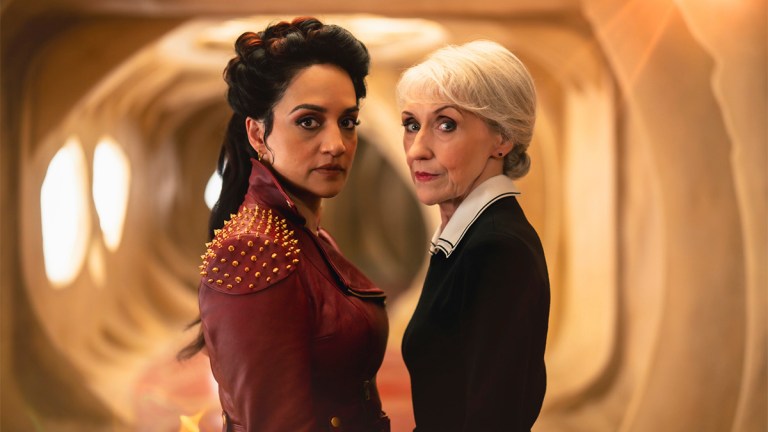Doctor Who: Steven Moffat’s Original Plan for The Rani Has Been Uncovered
The former Doctor Who showrunner wanted to bring back one of the Doctor's most famous adversaries for the show's 50th anniversary.

The final episodes of Doctor Who’s most recent season are controversial for many reasons. There’s Fifteenth Doctor Ncuti Gatwa’s surprise regeneration, the apparent return of former companion Billie Piper as the (maybe?) Sixteenth Doctor, and the fact that the season’s Big Bad turned out to be the renegade Time Lord known as Omega. But, one of the most exciting—and, in turn, frustrating—twists was the reveal that the mysterious Mrs. Flood, who had spent the better part of two seasons snidely breaking the fourth wall to address the audience throughout multiple episodes, was actually the rogue Time Lord known as the Rani.
A classic Doctor Who villain who hadn’t appeared on the main series since 1987’s “Time and the Rani,” the character had grown rather infamous in the modern era for not returning to the show’s canvas. (The characters who turned out to be Madame Kovarian, Missy, and the Fugitive Doctor? All initially speculated to be the Rani by many fans.) But showrunner Russell T. Davies finally pulled the trigger, and Mrs. Flood regenerated (biregenerated, technically) at the end of “The Interstellar Song Contest” into Archie Panjabi, a second version of the infamous Time Lady.
But, thanks to some intrepid fans, we now know that the Rani’s return was initially set to happen well before the Fifteenth Doctor era. Apparently, former showrunner Steven Moffat initially planned to bring the character back as part of the show’s 50th anniversary celebrations in 2013. Obviously, that plan never came to fruition, but it’s certainly entertaining to wonder what might have been.
This news comes courtesy of a Reddit user who, along with some friends, purchased a batch of early draft and/or shooting scripts for a handful of Moffat-era episodes, including “The Angels Take Manhattan,” “Time of the Doctor,” and “Phantoms of the Hex/The Hider in the House” (the episode that would eventually become “Hide”). However, the early script fans will likely be most interested in is the draft of the mini-episode “Night of the Doctor” that aired in 2013. Notable for finally showing us Eighth Doctor Paul McGann’s regeneration and the subsequent birth of John Hurt’s War Doctor, the minisode saw Ohila, a member of the Sisterhood of Karn, play a key role in helping the badly injured Time Lord choose his future.
But that’s not how things were originally supposed to go. In this earlier draft script, it is the Rani who explicitly pushes Eight toward becoming the warrior that’s needed to end the Time War. Granted, this technically doesn’t change all that much in terms of the episode’s events; the same basic plot beats still happen. “Night of the Doctor” is the first time we’ve seen the Doctor directly choose the path of a future regeneration in this way, deliberately embracing the idea of becoming the man (alien?) that’s needed to end the Time War, even though the violence inherent in such a choice goes against his established nature. But the idea that it was the Rani who explicitly pushed the Doctor toward the action that would become his greatest regret feels a lot more significant than having a character like Ohila do it. This choice complicates both her character and the relationship between the two Time Lords in interesting ways.
While the Rani has long been depicted as the Doctor’s adversary, she’s not necessarily a villain in the same way a character like the Master has (mostly) been. A scientist who is willing to sacrifice anything in the name of her research, she’s an amoral figure, but not a particularly vicious one. She doesn’t care much (or, really, at all) about who gets caught in the crossfire of her various projects, but her goal isn’t to cause harm or mayhem for its own sake. In this earlier version of “Night of the Doctor,” her decision to shape Eight’s regeneration is an almost completely selfish one—she’s primarily concerned with saving reality, and by extension, herself—albeit a decision that has an unexpectedly long-tail impact.
It’s easy to understand why the Rani was ultimately cut from this (mini) episode. While her return would have been absolute catnip for longtime Whovians and a fantastic nod to the show’s then-50 years on-air, “Night of the Doctor” is under eight minutes long. That’s not a lot of time to explain anything to newbies about who this character is or why it matters that she’s shown up at this crucial moment in the Doctor’s story.
“My script team felt I was throwing away the Rani on a minisode and we should hold her back – and while I didn’t entirely agree, I took the point,” Moffat said on X. “Given that I was throwing a spanner into Who continuity (an extra Doctor!) I wanted some Who lore in there to compensate —- hence the Sisterhood.”
But would this have been a better return for such a famous classic character than the one we ultimately got? Given “Night of the Doctor’s” extremely brief runtime, probably not — but it’s certainly fun to speculate about what might have been had the character returned to the series’ canvas a decade ago.
